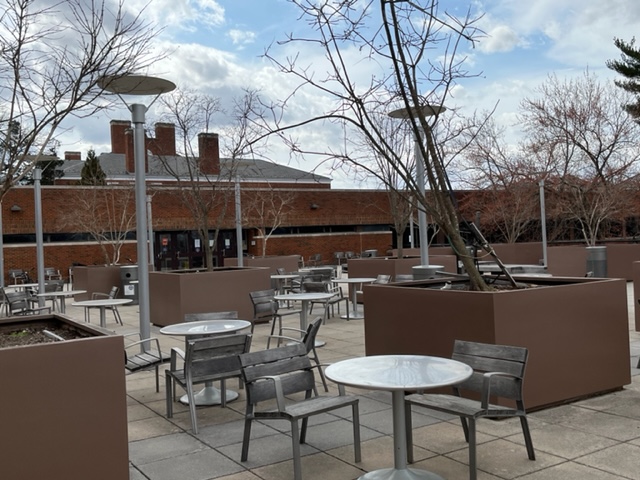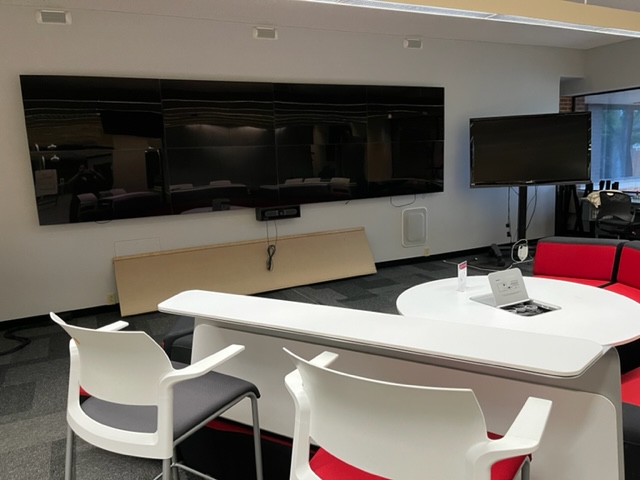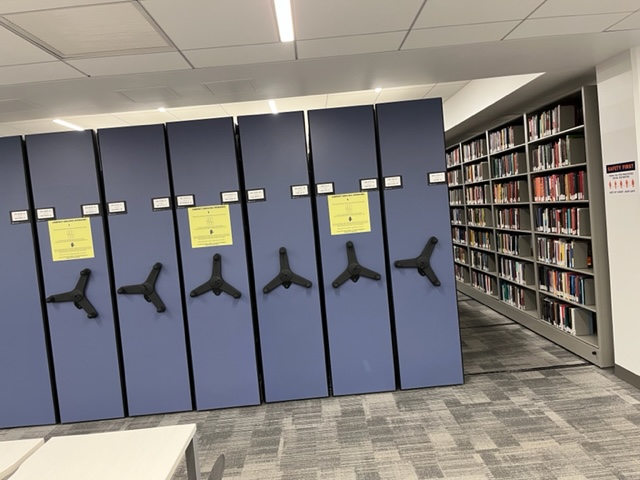
The Clemons Library, or “Clem,” is known as the undergraduate library, sits on the main campus of the University of Virginia. Clem is one library of the twelve at UVA built in 1980. From the exterior, there isn’t anything, in particular, that is extraordinary in comparison to the adjacent library built in 1931. A courtyard outside the entrance has multiple tables, chairs, bike racks, and a book drop. Despite the exterior feeling dated, I was pleasantly surprised to see a bright and modern space as you enter the library on the fourth floor of the four-story building. The fourth floor feels inviting for those who want to relax and socialize. However, the noise level was similar to a cafe, and I sensed that the fourth floor was more of a hangout space for students—the extensive service desk is staffed with three employees who were all students. My findings were consistent with Rubin and Rubin (2020), that reference librarians that once staffed the service desk are now staffed with students (p.140). The student employee was helpful and gave me the lay of the land before I set off on my own to explore. The majority of the fourth floor comprises communal work tables and cubicles, endless rows of tables and chairs, and a variety of seating options. I particularly enjoyed the rocking chairs while observing how students utilize the space. The library materials available were DVDs from film to tv. I was surprised by how extensive the DVD collection was. If I were a student, I wouldn’t need to pay for any streaming services; the library had everything I could want! The Periodicals/Journals were also available for check out and were a much smaller physical collection. The technology available on the fourth floor was a few public computers, multiple catalog stations, copy machines, scanners, and microfiche readers. While the microfiche readers remained untouched during my visit, the copy machines, scanners, and catalog stations were continuously used. After observing the layout of the fourth floor, I was able to understand Rubin and Rubin’s (2020) assertion that academic libraries place “greater emphasis on active learning and cooperative or collaborative learning in groups” (p. 137).
The third level is home to two library labs: the Robertson Media Center (RMC) and the Scholar’s lab. You approach the RMC service desk as you entire the third floor. The video studio or RMC video lab has various professional-level equipment, including cameras, a teleprompter, audio equipment, backdrops, lighting, and props. This space produces professional videos, interviews, recording class presentations, and shooting with a green screen. Before using the video studio, training and in-person assessment are required. The audio studio is excellent for recording podcasts, interviews, music production, or anything else that needs a professional audio studio. There are three audio booths with sound isolation technology with microphones, mixers, instruments, and a computer with multiple software applications for music and recording production. It was quite the setup, and I was impressed. Students can directly reserve audio booths on the website or ask the RMC service desk.
The Scholar’s lab had some of my favorite places on the third floor. The Immersive Virtual Reality Room is equipped with a PC, VR headset, and handheld motion controllers. If I attended UVA, I would spend a lot of time here. Students can reserve these spaces online.
The 3D printer space was on the third floor. Unfortunately, it was closed, but I could view the room from the outside. The lab has 9 FDM printers that are free for anyone to use at the university after a short online training! Patrons must sign up online to reserve the labs. I may need to attend one of the public workshops they offer to learn how to use the printers.
The G-Lab Classroom and Lab is a modular teaching space available for class reservations. It has 20 iMacs with various applications and two drop-down projection screens. When teachers are not reserving this classroom, it is available for walk-in use as a computer lab. The Digital Media lab is used for video editing, 3D modeling, and digital animation. In addition, each workstation is equipped with two high-end drawing screens. Scanning and transferring digital content are also available.
One feature I found interesting was the VizWall. It appeared to be a wall of monitors attached to emerge as one giant tv screen. The Vizwall is used for presentations, technology demonstrations, media events, and class projects. You may link up to four computers at a time or display a single computer across all monitors and can be reserved online. My first thought was this would be an excellent movie screening room!

The makerspace or “TinkerTank” is available to students. This was my first time seeing a real makerspace. I felt slightly overwhelmed but quickly felt comfortable after speaking to the makerspace technologist who shared the students’ latest project. A. Shepherd (personal communication, March 7, 2022) shared students collaboratively built a photo booth. Upon premiering their work, 650 students lined up to take photos. In addition, he said he offers ten technology workshops to students and the public per semester—what a fantastic way to collaborate with your peers.
As I walked down to the second floor, I started thinking, where are the books? The George’s Center is devoted to student advising and study spaces independently and collaboratively. In addition, there are many small meeting rooms and conference rooms with large monitors to present and share information. This floor is specifically designed for flexible use. The great space offers 20 different programs that include advising hours, workshops, financial aid services, Pre-Health advising, Law Advising, and a College Life Skills Coach. Patrons occupied many conference rooms, some in large groups, in pairs, or solitude. Since I visited during spring break, the open floor space was empty, except for a few students eating and socializing in the cafe section of this floor. I asked them what it usually is like when school is in session, and they shared that the second floor is the busiest in the building. There is a constant flow of students, faculty, and staff working together or independently, and it is the heart of the library. According to Rubin and Rubin (2020), there are nine principles for Standards of Libraries in Higher Education. One of them relates to space: “libraries are the intellectual commons where users interact with ideas in both physical and virtual environments to expand learning and facilitate the creation of new knowledge” (p. 135). The interactions I witnessed at the George’s Center reinforced this principle and that libraries are more than just books.
Speaking of books, as I walked down to the first floor, I wondered, where are the books? As I entered the ground floor, I was relieved to see the endless stacks of books and not a service desk on site. This was my first experience with compact shelving. At first, I was perplexed how they worked and was worried I might get crushed, but I quickly got over it and lost myself and time in the stacks. I was impressed with the extensive collection; anything I could want, they had it. Everything is organized by the Library of Congress, which I am unfamiliar with, so it took some time to use the catalog and navigate through the compression stacks to find what I was looking for. However, I was impressed by the diversity and the number of books they had written in many languages. The fifth Standards for Libraries in Higher Education principle is about Collections and how “libraries provide access to collections sufficient in quality, depth, diversity, format, and currency to support research and teaching missions of the institution” (p. 135). I was the only patron on this level, so it was fun having the place to myself. I got excited that they even had an old card catalog! A librarian finally greeted me and explained how the compression shelves worked, and offered help if needed. At the end of the stacks, two rows of study tables were empty.
The website is extensive and easy to navigate. According to UVA’s website, there are 220+ library staff, 330+ student employees, 4.7 million books, 993,500 E-books, 20 million manuscripts, and archives, 290,000 journal subscriptions, and 358,000 media items. I even used the “Ask a librarian” chat feature to ask what year the Clem library was built because I could not find it. Within a couple of minutes, they responded with news articles about when it opened. The catalog is called “Virgo” and was easy to locate items. Because of how extensive the website is, I imagine it can be overwhelming for some, especially those whose English is not their first language. However, 29 different languages are spoken among the staff so it is possible that may not be an issue.
I found it disappointing that the compression stacks are not ADA compliant. Many stacks were closed or too narrow, which would make it nearly impossible to locate materials independently if you have mobility issues. Additionally, the stacks were quite tall, with seven shelves in total. The top two shelves and the bottom shelf are entirely inaccessible to people who are short or who have mobility issues. As an independent library user, I wouldn’t want to ask for assistance in locating library materials constantly.

Two unexpected positive experiences were the smart toilet on the fourth floor. I had never used one before, and now I want one for my home! Who knew a toilet could have so many features! The other was how helpful and friendly all the staff was on every level of the library. Someone sought me out and asked if I needed assistance, then was available when I needed help. The entire experience made me feel welcomed and valued as a patron.
References
Rubin, R. E. and Rubin, R. G. (2020). Foundations of library and information science (5th ed.). ALA Neal-Schuman.
University of Virginia Library. (n.d.). About UVA library. https://www.library.virginia.edu/about-uva-library/
University of Virginia Library. (n.d.). Ask a librarian. https://www.library.virginia.edu/askalibrarian
University of Virginia Library. (n.d.). Virgo. https://search.lib.virginia.edu/
The technology that this library supplies sounds amazing! It shows how much students utilize media more now than when I was in college. I think it is wonderful that these rooms are available at no cost; the patrons just need to be trained. Since I have never seen compression stacks, I am glad you provided a picture. It seems a little intimidating to use. I agree with you that people with disabilities would not be able to easily access some of the shelves; however, it sounds like the staff is readily available to help with this dilemma. Overall, the Clemons Library seems like a welcoming place for students to take advantage of the technology provided, research the collection, or study in one of the many rooms offered.
I couldn’t agree more about the technology! I was in my techie geek heaven. If I attended UVA, I most likely would spend most of my time on the technology floor. Students at UVA have so many resources available to them and for free! I am still trying to wrap my head around the compression stacks, and maybe it is like that in many academic and government libraries. However, I believe storing print books in that way while it saves space; you do need to ask a librarian or library staff for assistance, even if you are non-disabled. I was timid to move the stacks, mostly because I didn’t want to break them or make too much noise. Overall, I thoroughly enjoyed my library visit to Clemons Library.
The Clemons Library is quite impressive. The technology workshops offered for students and the public are an excellent way to allow students to work together. I would feel a bit intimidated by that area and would need to take one of those offered workshops. The spaces seem very welcoming for students, and I think the outside space would be an excellent spot to work. I was glad to hear about all the helpful student staff!
I also was glad to hear they offer free workshops to students and the public. There was a lot of equipment available for free that I wouldn’t know how to work if there wasn’t some training provided. I think it’s an excellent resource for UVA!
The amount of available technology and equipment amazes me! Overall, this library seems like a wonderful resource and a great place to visit. I have never seen compact shelving! I agree that accessibility would be quite an issue, and I wouldn’t want to ask for help multiple times. In fact, I don’t have mobility issues, but I would feel the need to ask for help.
The technology is impressive. It makes me wonder how other state universities compare. The next time I encounter compression stacks, I think I will bite the bullet and ask for help. I’m curious how they work, and it could be easy; I just didn’t feel comfortable moving them on my own this visit. I didn’t want to break or push it strangely, and then a slow, embarrassing domino effect happened!